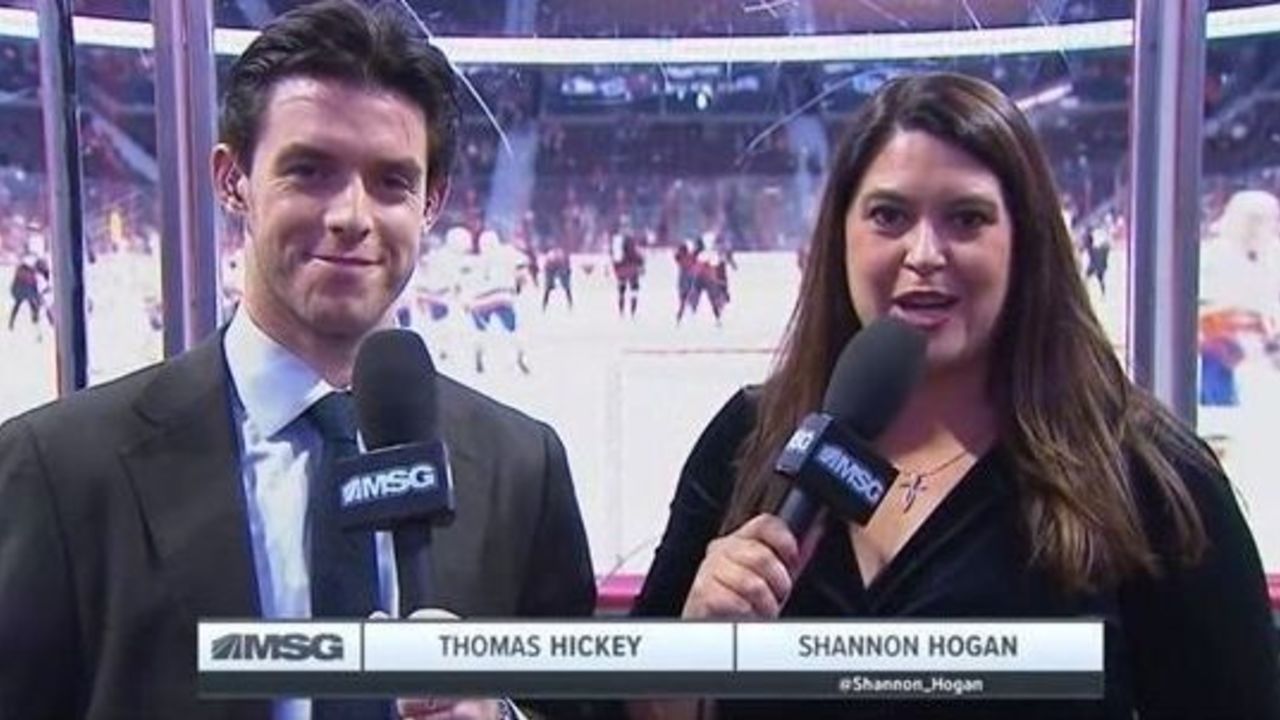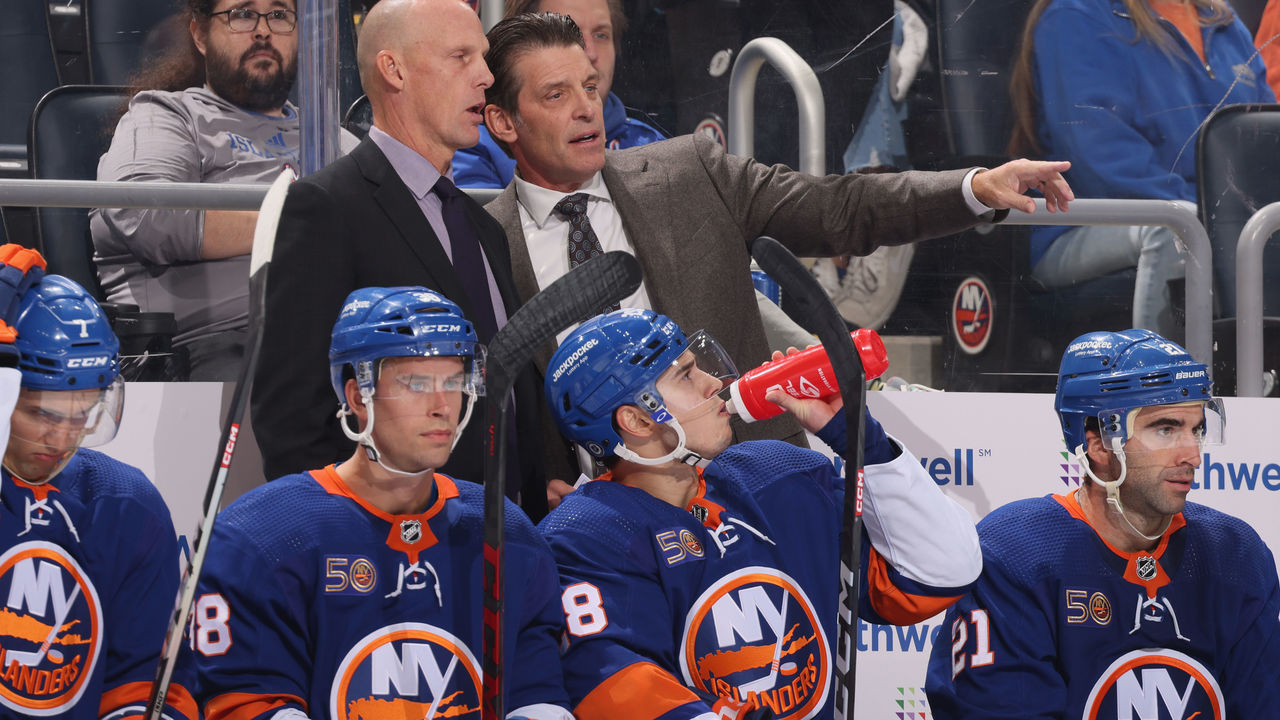Isles reap rewards of riskier hockey, McDavid's tear, and 4 other NHL items
Technically, Thomas Hickey hasn't retired from pro hockey. The longtime New York Islanders defenseman has yet to file the paperwork to make it official.
For all intents and purposes, though, Hickey is retired, and he's already a few months into a second career, having transitioned to a studio analyst role with MSG Networks following his release from the New Jersey Devils during training camp. He works Islanders broadcasts alongside host Shannon Hogan on the pregame, intermission, and postgame shows.

For a rookie analyst, Hickey, 33, is polished and especially adept at translating on-ice tactics into plain English. His biggest challenges at the moment are learning TV industry lingo and presenting the right body language to the camera. It took a minute, but he has managed to reframe the Isles in his brain.
"I remember saying 'we' early on, and somebody was in my ear going, 'OK, watch the we. You don't want to say we,'" Hickey, an Islanders player from 2012-2022, said Thursday during a phone interview. "And I know (that's the proper approach) because I don't play for the team. ... It's something you try to snap out of."
After our conversation, the Isles lost 4-2 to the Edmonton Oilers, dropping their record to 22-16-2, points percentage to .575, and goal differential to plus-18. New York, which failed to make the postseason in 2021-22, is the Eastern Conference's second wild-card team heading into Friday's games.
"This team is where they deserve to be," Hickey said, before adding that it'll be a "fight until the very end" in the Metropolitan Division. The Isles are in fifth place with 46 points, four behind the third-seeded Rangers.
"It's clear that the bedrock of the team is goaltending, and the team will go as far as the goalies will take them," Hickey said of Vezina Trophy contender Ilya Sorokin (.925 save percentage) and backup Semyon Varlamov (.919). "Through 40 games, they've proven that's not going to be an issue and that's something you can rely on. And they've also proven they can score, too."

The Isles are icing essentially the same roster as last season, but first-year bench boss Lane Lambert has installed a less conservative system than that of Barry Trotz, the coach behind trips to the conference finals in 2020 and 2021.
Backstopped by elite goaltending, Lambert's Islanders are fine with exchanging more scoring chances and goals against for more chances and goals for. The results are promising: The Isles are up to 15th in the league from 23rd last year in goals per game - a 12th-ranked power play helps - while sitting eighth in goals against per game, the same as last year.
To Hickey, the starkest change from Trotz - who he played for - to Lambert, previously an assistant, can be seen in "the aggression in the offensive zone."
"Barry was conservative in the sense that when you're trying to win games 2-1 or 3-2, you don't need to risk having the defenseman pinch down the walls in the O-zone when it's maybe a 60-40 play," Hickey explained. "That's 60% you will get the puck, 40% you won't, and that 40% can really bite you.
"This year, it's a go-for-it mentality, and it's become somebody else's responsibility to fill in at the (vacant) point. You can create so much more offensive-zone time when you do take those educated risks and bets, keep a puck in, and then play in the other team's zone for 40, 50, or 60 seconds."
Lambert encouraging his blue-liners to pinch, and, as Hickey points out, to also join or lead the rush on the breakout, has the Isles ranking first in the league in goals by defensemen, with 25. Last year, New York's rearguards combined for 32 goals over 82 games, which tied them for 21st.
"The team is understanding that, after playing such a conservative game for so long, you can add risk and still win hockey games," Hickey said.
"What's the right amount of risk? I think they're still finding that out."
McDavid's underappreciated tear

Let's talk about Connor McDavid. More specifically, let's talk about the damage he's been inflicting on opponents night after night since October.
McDavid, who turns 26 next Friday and is now in his eighth NHL season, has amassed 33 goals and 42 assists for 75 points in 40 games. The Edmonton Oilers captain leads the NHL in points by 15, primary points by six, and points per game by 0.30. (Teammate Leon Draisaitl is second in all three categories.)
McDavid has been held off the scoresheet only five times all year and has factored in 53% of all Oilers goals. To truly understand what McDavid's been up to over the past three months, consider this: The Chicago Blackhawks have 80 goals in 37 games - just five more goals than McDavid has points.
McDavid's been comically hot for a while now, and I don't think he's getting enough attention. But I get it; McDavid's greatness is nothing new. And like LeBron James, he's never not been great, so we're a bit numb to it.

Assuming McDavid stays healthy, here are three plausible second-half scenarios:
Scenario 1: Continues current pace
McDavid, who hasn't missed a game this season and is nearly averaging a career high in ice time at 22:46, is on pace for 68 goals and 86 assists for 154 points. His best comparable in recent history is Mario Lemieux, who piled up 69 goals and 92 assists for 161 points in 70 contests in 1995-96.
Lemieux recorded 150 points or more three other times. Wayne Gretzky did it on nine occasions, while Steve Yzerman, Phil Esposito, and Bernie Nicholls all hit 150 once. That's it; five 150-point guys in NHL history. And only nine players have ever hit the 68-goal mark.
Scenario 2: Reverts back to career pace
It's possible McDavid loses his momentum in the second half and over his final 42 games produces at his career averages heading into the season.
If that's the case, he'll accrue 21 more goals (0.50 goals-per-game average) and 40 more assists (0.96), bringing his 2022-23 totals to 54 goals and 82 assists for 136 points. He'll still establish career bests in all three categories and likely win his fifth Art Ross, third Hart, and fourth Ted Lindsay trophies.
Scenario 3: Produces below career pace
While less likely, it's possible McDavid struggles. For argument's sake, let's say "struggles" means the superstar produces at half of his career averages.
Under these terms, 0.25 goals per contest over the final 42 games will lead to 11 more goals, while 0.48 assists per contest will yield 20 additional assists. His totals: 44 goals (ties career high) and 62 assists for 106 points in 82 games.
So, McDavid will still eclipse 100 points for the sixth time if everything falls apart from January onward. What a phenomenal first half.
Kings' Kaliyev slowing evolving

Arthur Kaliyev's calling card has always been his ability to fire the puck. The Los Angeles Kings, despite being well aware of on-ice red flags that were turning other teams away, drafted him 33rd overall in 2019 precisely for his goal-scoring.
However, Kaliyev's howitzer can take him only so far. When the puck isn't going in, for whatever reason, the 21-year-old winger must find subtler ways to make a positive impact. His transition to the pro ranks hasn't been seamless, but prior to going down with a lower-body injury on Dec. 20, Kaliyev had been flashing glimpses of a well-rounded game.
"He's realized the stats will come if you do all of the other things," Kings head coach Todd McLellan said recently. "He's added an element of physicality to his game that wasn't there. He's bigger, he's stronger, he's fitter. He's been able to improve his engine so that he can play more minutes at a higher pace. The improvement in his game has been noticeable over the last year."
Kaliyev, who's spent time on every forward line this season, is averaging just 12 minutes of ice a night. He's been active during his shifts, though, leading L.A. in shot attempts per 60 minutes (20.93, 146 total attempts) and sitting second in goals per 60 (1.29, nine total). Both rates are upgrades on last year's numbers when Kaliyev played 80 games as a wide-eyed NHL rookie.

As McLellan mentioned, Kaliyev has ratcheted up his physicality, going from 1.84 hits for per 60 and 6.29 against per 60 last season to 4.01 for and 7.45 against this season. It's a key development, as a lack of physical engagement and slow pace of play were the two main concerns ahead of the 2019 draft.
Is the hope, then, that the 6-foot-2, 210-pounder can evolve from a one-dimensional, trigger-happy forward to a trustworthy power forward who scores, wins puck battles, and bowls over the odd opponent? McLellan answered "yes," before wondering aloud about the player archetype.
"I don't know what a power forward is anymore," he said. "Is a power forward the guy who is running over guys and commanding ice? Or is a power forward the guy that's bombing pucks by a goaltender? Is he established in the crease or does he play on the perimeter and scores? I'm not sure what the definition is anymore. We're at that stage right now."
Parting shots
Sticky business: Trevor Zegras' stick broke mid-shift Wednesday, so he decided to steal one from the Dallas Stars' Joel Kiviranta - right out of the poor guy's hands. The face of the Anaheim Ducks was quickly issued a minor penalty for using an illegal stick. Nevertheless, it was an amusing sequence in a 2-0 Ducks win. (See below.) I found Zegras' postgame remarks especially funny. "Everybody knew it was a penalty but me, I guess," he told reporters with a veiled grin. He then added, "I tried to claim that I found it on the ice, which nobody was buying."
Trevor Zegras needed a stick. Joel Kiviranta had one. 😂 pic.twitter.com/JfqW3f94Oi
— Saad Yousuf (@SaadYousuf126) January 5, 2023
Tracking data: Earlier this week, NHL public relations passed along some 2022 player and puck tracking data highlights. Buffalo Sabres star sniper Tage Thompson recorded the hardest shot in a regular-season game - 101.69 mph on Nov. 8 against the Arizona Coyotes. Ottawa Senators defenseman Thomas Chabot traveled the longest distance in a regulation game - 24,748 feet on March 14, also against Arizona. That's 4.7 miles or 7.5 kilometers. And McDavid skated the most total distance - 1,609,734 feet (305 miles/491 km) over 72 games during the calendar year. Wow, OK, now I'm curious about No. 97's crossover numbers:
Connor McDavid is at it again with his linear crossovers to pick up and maintain deceptive speed
— Greg Revak, CFP® (@CoachRevak) February 1, 2022
It’s all in the crossovers = 6 crossovers to 1 forward stride pic.twitter.com/kI15OlarGZ
Moritz Seider: The Detroit Red Wings blue-liner's points-per-game rate has dropped from 0.61 last year to 0.36 this year. It can be tempting to slap the "sophomore slump" label on Seider, but there's nuance here. How do the Red Wings view the Calder Trophy winner's performance so far in Year 2? "Excellent," head coach Derek Lalonde told theScore last week. "I think the biggest thing with Mo is that he's continuing to play winning hockey. It's not about offense. It's not about what he creates. It's about winning. You can see, in games where he's been really good and we've won, he's been a huge part of defending against their top line and leading the breakout. If the offense comes, great, but it's him managing his game, not turning pucks over."
One thing I would love to see in 2023:
— Ian Mendes (@ian_mendes) January 1, 2023
A Senators-Red Wings regular season game in Germany.
How great would it be to showcase young stars like Stützle & Seider in their home country?
Takes, Thoughts, and Trends is theScore's biweekly hockey grab bag.
John Matisz is theScore's senior NHL writer. Follow John on Twitter (@MatiszJohn) or contact him via email ([email protected]).